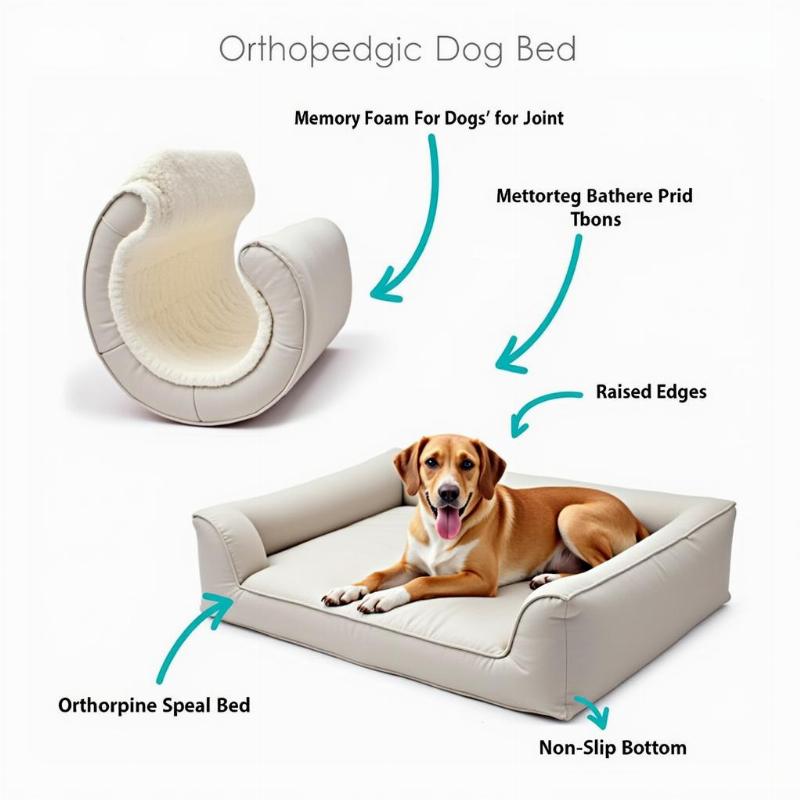Strengthening your dog’s hind legs is crucial for their mobility, overall health, and quality of life. Whether your furry friend is a senior experiencing muscle loss, recovering from an injury, or simply needs a boost in their back-end strength, this guide provides practical, vet-approved strategies for building muscle in your dog’s hind legs. We’ll cover targeted exercises, nutritional advice, and lifestyle adjustments to help your canine companion regain strength and maintain an active, happy life.
Understanding Hind Leg Weakness in Dogs
Several factors can contribute to hind leg weakness in dogs. Age-related muscle atrophy, especially in senior dogs, is a common culprit. Injuries, such as torn ligaments or hip dysplasia, can also significantly impact hind leg strength. Certain breeds are predisposed to conditions that affect the hind legs, like German Shepherds with degenerative myelopathy. Identifying the underlying cause of weakness is critical for implementing the right strengthening plan. Consult with your veterinarian for a thorough diagnosis and tailored recommendations.
Targeted Exercises to Strengthen Hind Legs
Here are some effective exercises that can help build muscle in your dog’s hind legs:
- Sit-to-stands: This classic exercise mimics the motion of getting up from a seated position. Start with a few repetitions and gradually increase the count as your dog gains strength.
- Controlled Leash Walks: Uphill walks provide resistance and engage the hind leg muscles. Maintain a slow and steady pace to avoid strain.
- Swimming: This low-impact exercise is excellent for building muscle and improving overall fitness. If your dog enjoys swimming, incorporate it into their routine.
- Cavaletti Rails: These low obstacles encourage your dog to lift and extend their legs, strengthening the hindquarters. Start with low rails and gradually increase the height as your dog progresses.
- Walking on uneven surfaces: dog walking sideways with back legs can strengthen the muscles.
Remember to start slowly and gradually increase the intensity and duration of exercises. Observe your dog for signs of fatigue or discomfort and adjust accordingly. Always consult with your veterinarian before starting a new exercise program, especially for dogs with pre-existing conditions.
Nutritional Support for Muscle Growth
Proper nutrition plays a vital role in muscle development and recovery. Ensure your dog’s diet includes high-quality protein sources to support muscle growth and repair. muscle loss in dogs hind legs could be a sign of nutritional deficiency. Discuss with your vet about incorporating supplements like glucosamine and chondroitin to support joint health and mobility.
Lifestyle Adjustments for Hind Leg Health
 Giường hỗ trợ cho chó
Giường hỗ trợ cho chó
In addition to exercise and nutrition, certain lifestyle adjustments can help promote hind leg health:
- Maintain a Healthy Weight: Excess weight puts added strain on the joints and muscles, exacerbating hind leg weakness.
- Provide a Supportive Bed: A comfortable and orthopedic bed can help alleviate pressure on the joints and promote restful sleep. Consider a dog cart for paralyzed dogs for extreme cases.
- Use Ramps or Stairs: These assistive devices can help dogs navigate stairs and furniture, reducing strain on the hind legs. A dog harness for paralyzed dogs can help support their movement. Consider back leg support for old dogs for senior dogs.
Conclusion
Building muscle in your dog’s hind legs requires a multi-faceted approach encompassing targeted exercises, nutritional support, and lifestyle adjustments. By implementing these strategies, you can help your furry friend regain strength, improve mobility, and enjoy a more active and fulfilling life. Remember to consult with your veterinarian for personalized recommendations and ongoing support.
FAQ
- How often should I exercise my dog’s hind legs? Start with short sessions a few times a week and gradually increase the frequency and duration as your dog’s strength improves.
- What are signs of hind leg weakness in dogs? Signs may include difficulty standing, walking, climbing stairs, or a wobbly gait.
- Can supplements help with muscle growth in dogs? Certain supplements, such as glucosamine and chondroitin, can support joint health and mobility.
- What type of bed is best for dogs with hind leg weakness? An orthopedic bed can provide support and alleviate pressure on the joints.
- How can I help my senior dog with hind leg weakness? Gentle exercises, a supportive bed, and ramps can help senior dogs maintain mobility.
- Are there specific breeds prone to hind leg problems? Yes, some breeds like German Shepherds and Dachshunds are more susceptible to certain conditions.
- When should I consult a vet about my dog’s hind leg weakness? Consult your vet if you notice any signs of weakness or discomfort to determine the underlying cause and receive appropriate treatment.
Beautdogs.us is your premier destination for expert advice on dog breeds, care, and products. We’re passionate about providing dog owners with the information and resources they need to ensure their furry companions thrive. Whether you’re a seasoned dog owner or just starting your journey, Beautdogs.us offers insightful content, product reviews, and expert guidance to support you every step of the way. For any questions, contact us at [email protected] or call us at +1 501-555-7529. Visit Beautdogs.us today to learn more!